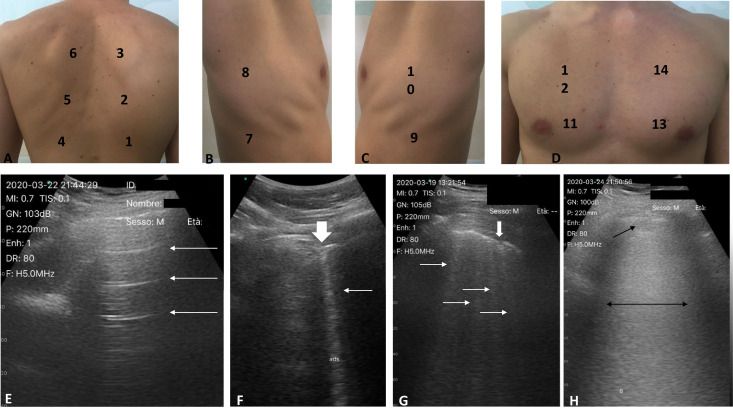Predicting Risk of COVID-19 Risk of Death with POCUS
Bedside lung ultrasound can be used to pinpoint which emergency department patients are more likely to die from viral infection.
Point-of-care ultrasound can accurately predict which COVID-19 patients are at a greater risk of death on initial lung scans, new research has found.
According to clinicians from Rome’s Agostino Gemelli University Policlinic hospital, using this bedside modality in the emergency department can be an effective way to identify which patients are more likely to have severe outcomes from the viral infection. They published their findings in the July 15 issue of Ultrasound in Medicine & Biology.
“Our study shows that lung ultrasound, performed in the emergency department by emergency physicians, is able to predict at the first evaluation the overall prognosis of COVID-19 patients, recognizing those needing ICU admission and those at higher risk of death,” wrote the team led by Nicola Bonadia from the hospital’s emergency department.
This is the first study, according to the authors, to examine the predictive role of lung ultrasound in COVID-19-positive patients.
Related Content: Contrast-Enhanced Ultrasound Can Pinpoint Lung Findings Unique to COVID-19
To determine how well point-of-care lung ultrasound works in evaluating COVID-19-positive patients in the emergency department, Bonadia’s team conducted bedside scans on all patients with suspected viral infection between March 1, 2020 and March 31, 2020. They scanned 14 areas of the lungs with a pocket-sized device that included a 6Mhz wireless convex probe. All total, they included 41 COVID-19 patients over age 18 with known outcomes in the study.
The team analyzed the scans from each patient, giving scanned areas a score of 0 to 3 depending on the severity of the findings. A score of 3 indicted the most severe lung disease, including white lung with or without subpleural consolidations.
Representation of Lung Ultrasound score for COVID-19 patients according to Soldati et al (13). Figures 1a to to1d1d show the localization of the 14 areas evaluated with Lung Ultrasound. Figure 1e shows a Lung ultrasound score 0 (normal pattern), with clear A-lines (horizontal artifacts, white arrows). Figure 1f shows a Lung ultrasound score 1, with pleural line irregularity (white, thick arrow) and a single vertical artifact (B-line, white arrow). Figure 1g shows a Lung ultrasound score 2, with pleural line irregularity (white, thick arrow) and a multiple but not confluent vertical artifacts (B-lines, white arrow). Figure 1h shows a Lung ultrasound score 3, with a subpleural consolidation (black arrow) and a large area of white lung (double-head black arrow). Courtesy: Ultrasound in Medicine and Biology

According to the findings, the team said, all 14 lung areas scanned had pathological findings with most occurring in the lateral lung regions. Overall, more than 90 percent of these patients had at least lung area with an abnormal lung finding.
Among those patients who died, every scanned area contained a pathological finding. Patients who were ultimately discharged had similar findings in 50 percent of scanned areas. Their lung ultrasound scores were 1.43 and 1.0, respectively. In addition, patients who were ultimately admitted to the ICU presented pathological findings in 93 percent of scanned lung regions while those not admitted experienced pathologies in only 20 percent of areas. They also had lung ultrasound scores of 1.36 and 1.0, respectively.
For the purposes of determining the presence of COVID-19 pneumonia, Bonadia’s team identified a distinct lung ultrasound score cutoff of 0.4 and a 20-percent pathological findings rate. No study participants with a lung ultrasound score of less than 1.1 and a pathological findings rate until 70 percent died.
Even though the study was conducted in one institution with a small participant pool, Bonadia’s team said they hope their results can improve the triaging of COVID-19 patients and, potentially, ignite additional research efforts around how well lung ultrasound scores can impact decision-making around hospital admissions and treatment.
The Reading Room: Racial and Ethnic Minorities, Cancer Screenings, and COVID-19
November 3rd 2020In this podcast episode, Dr. Shalom Kalnicki, from Montefiore and Albert Einstein College of Medicine, discusses the disparities minority patients face with cancer screenings and what can be done to increase access during the pandemic.
What New Research Reveals About Novice Use of AI-Guided Cardiac Ultrasound
April 4th 2025In a study recently presented at the American College of Cardiology (ACC) conference, researchers found that novice use of AI-guided cardiac ultrasound after an AI-enabled electrocardiogram increased the positive predictive value for reduced left ventricular ejection fraction (LVEF) or aortic valve stenosis by 33 percent.